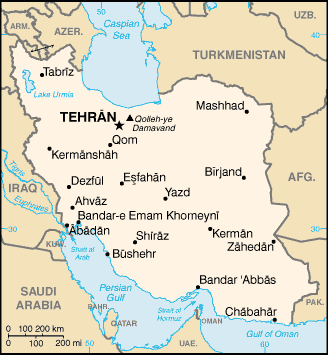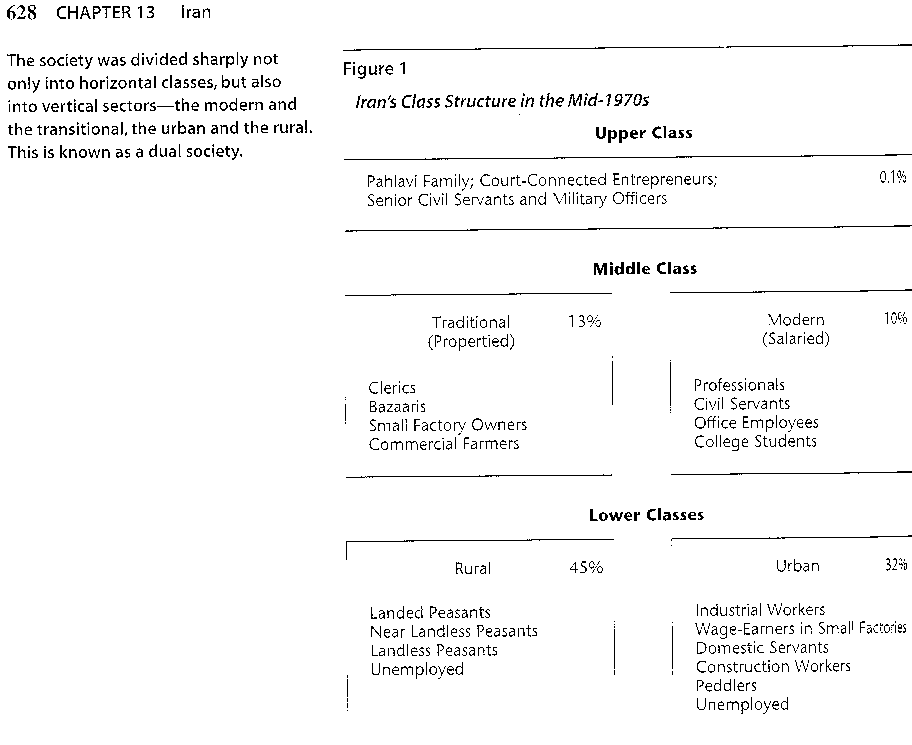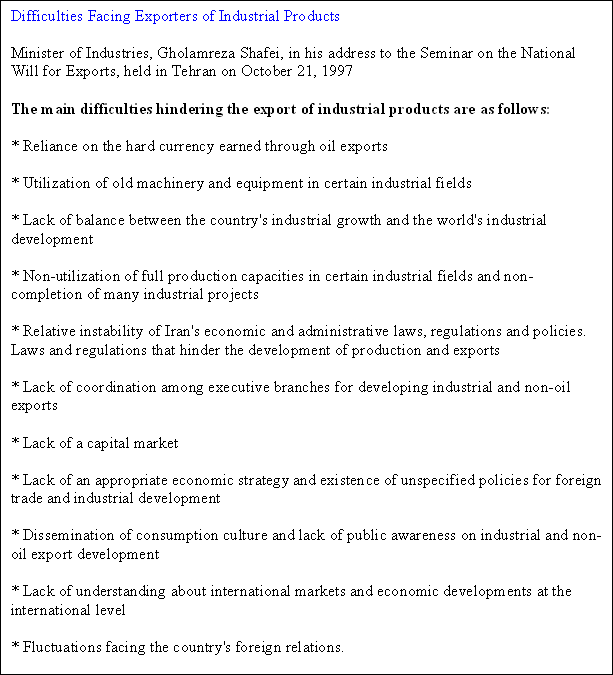

Iran’s
Politics: Part 1
I.
Basic themes found in discussions of Iranian politics
a. Long tradition of existence as a civilization
b. Weak administrative development
c. Pivotal spot in Middle East, vulnerable to invasion and foreign domination
d. Alternation between nationalism and foreign dependency
e. Mixed cultural influences (Islam, Turk, Kurd, Arab, etc.)
f. Population concentrated in Caspian area and in urban zones
g. Agriculture limited by lack of arable land
h. Oil export dependence both helps and hurts economic development, democratization
II.
Identity and Regimes
a.
Periods
i.
SAFAVIDS 1501-1724
ii.
QAJARS 1794-1925
iii.
PAHLAVIS 1925-79
iv.
ISLAMIC REPUBLIC 1979-
b.
SAFAVIDS -
1501-1724
i.
Major accomplishments
1. Forced conversion to Shi’a version of Islam for national identity
2. Inherited weak administrative structure, did little to improve it
3. Militarily weak, due to inability to effectively tax and thus pay for a large standing army
4.
Ruled
through reliance on local, traditional elite
c.
QAJARS
ii.
Major accomplishments
1. After retaking Iran from Afghan control, reintroduced weak administrative state structure
2. Oversaw the development of strong European (esp. British) presence within Iran, ceding GB many economic advantages including control over customs/duties
3. Ran up large debts due to weak development, taxation capabilities
4. Constitutional revolution 1905-09
a)
Nationalist
revolt against foreign domination
b)
Popular
revolt against arbitrary Monarchical rule
c)
State
structures (military, police) too weak to oppose
d)
Written
constitution emerges
ii.
Establishes the MAJLES as parliament
iii.
Deep controversy over role of state/church
1.
Shi’a
made official religion
2.
Clerical
courts and sharia applicable in family law
3.
Guardian
Council, given veto power over bills deemed “unIslamic” but not convened
until 1979
iv.
Constitutional structure doesn’t firm up state, which proves still
easily dominated by Russia and GB
d. PAHLAVIS 1925-1979
i. Major accomplishments
1. Colonel Reza Khan – conducts military coup against QAJARS
2. Maintains MAJLES, takes over “SHAH” role
3. gives assurances to GB and SU as to neutrality
4. Son takes over during WWII
5.
Growth of popular movements
a. Tudeh Party (Communist)
b. National Front (Populist, Nationalist) Mosaddeq
c. NF/Mosaddeq becomes prime minister in 1951, nationalization of oil
d. CIA/GB unite with royalist officers to overthrow Mosaddeq in 1953, reinforces executive branch – SHAH as supreme leader
6. Strengthening of state under the SHAH
a. SHAH builds up central bureaucracy
i. Works as extensive patronage network
ii. Highly centralized control over periphery – appointment of local leaders
iii.
Rising costs of maintaining state structures
1.
Buildup
of major ministries
a.
Justice
1.
Elimination of shari’a and clerical courts perceived as attack on
authority of Islamic clergy
b.
Education
2.
Expansion of schools, secular education
c.
Transportation
3.
Road construction
4.
Communications
d.
Industry
5.
Build-up of light consumer industries
e.
Agriculture
6.
White Revolution
iv.
Military buildup
1.
Heavy
dependence on American armaments
2.
Excessive
spending
3.
Regional
“policeman” role
4.
Criticized
for pandering to US
6. Contradictions of Pahlavi period
a. Economic shortcomings -
Rentier state
1.
Oil
dependence unabated
2.
Govt.
financed almost entirely by oil revenues, although significant revenues didn’t
happen until 1960s and 70s
a.
Relative
autonomy of Iranian state
b.
Little
demand for taxation of population
c.
Insufficient
strengthening of state structures for tax collection
d.
No need
to open up political system since little demanded of public
b. Economic growth couldn’t keep up with population explosion
i.
Diversification
of industry limited, few exports
ii.
Foreign
investment limited due to govt. corruption, high labor costs, small internal
market, fear of political instability and/or confiscation
iii.
Trickle
down economic theory
a.
Focuses
on providing major contracts and low cost loans to well connected businesspeople
i.
Too much patronage
ii.
No effective evaluation of merit of proposals and efficiency of outcomes
b.
Causes
growing inequalities
i.
Rich and poor – second to Brazil
ii.
Regions
iii.
Urban/rural
1. White Revolution creates middle class, but leaves majority out of luck, movement to urban shantytowns

| Land Ownership in 1977 | Number of Owners |
|
Farm Size in hectares |
|
| 200+ | 1300 |
| 51-200 | 44,000 |
| 11-50 | 600,000 |
| 3-10 | 1,200,000 |
| Landless | 700,000 |
| Number of Factories | # in 1953 | # in 1977 |
|
Size |
||
| Small (10-40 wkrs) | under 1000 | Over 7000 |
| Medium (50-500 wkrs) | 300 | 830 |
| Large (0ver 500 wkrs) | 19 | 159 |
| Industrial Production | 1953 | 1977 |
|
Product |
||
| Coal (tons) |
200,000 |
900,000 |
| Iron ore (tons) | 5000 | 930,000 |
| Steel (tons) | 0 | 275,000 |
| Cement (tons) | 53,000 | 4,300,000 |
| Sugar (tons) | 70,000 | 527,000 |
| Tractors (#) | 0 | 7700 |
| Motor vehicles (#) | 0 | 109,900 |
| Urban Household Consumption Expenditures | Poorest 40 | Middle 40 | Richest 20% |
|
Year |
|||
| 1972 |
16.7 |
36.2 | 47.1 |
| 1977 | 11.7 | 32.8 | 55.5 |
c.
SHAH
follows “Saddamomics”
i.
Builds palaces
ii.
Lavish life style for himself, family and “court”
iii.
Reinforces idea that he is out of touch
c. Involuntary “state
corporatism” followed by anarchic liberalization
1.
1975 –
SHAH creates “Resurgence Party” in one party state
2.
Creates
state run “mass organizations” for employers, workers, women, youth
3.
State
control over media
4.
Executive
power unchecked…
5.
1977-78
liberalization
6.
Opposition
mounts, leading to mass demonstrations and general strike, growth of cleric led
“Revolutionary Committees” fueled by $ from bazaar
7.
Defections
within military spell end of SHAH’s regime
v. The opposition
a. Critique – multi-faceted
1. Political
a. Repression, lack of democracy (Liberal
critique)
b. Too pro-Western, insufficiently
“nationalist” (anti-western
critique)
2. Cultural
a. Too secular and western
b. Out of touch with popular
culture
3. Economic
a.
too much
inequality
b.
too much
Western dependence
c.
Harms
local small bourgeoisie
d.
Not
enough employment
b. Opposition’s alternatives
i.
Liberal
1.
Democracy,
republican
2.
Remain
pro-western
3.
Remain
mostly market oriented
4. Favors “modernity”
ii.
Leftist
1.
Democracy,
republican or communist
2.
More
extreme nationalists, less pro western, more “anti-imperialist”
3.
More
state planning, ownership of means of production
4.
More
equality
5. Mostly modern, urban, populist but not religious, obscurantist, no immediate cult of personality
iii.
Religious
1.
Limited
democracy, theocratic but anti-monarchical
2.
Pro
Islamic, anti-western, anti-imperialist
3.
Islamic
economics – mixed state, market
4.
More
charity, more equality
5.
More
traditional, rural, populist, prone to cults of personality around religious
figures
E. Islamic Republic
1.
Transition to Islamic Republic
a.
Ayatollah
Khomeini becomes symbol of opposition to SHAH
b.
Khomeini
passes referendum giving himself autocratic power
c.
Constitution
written by narrowly elected “Assembly of Religious Experts” passed by
referendum in undemocratic context – no opposition access to media, ability to
organize against referendum, Revolutionary Guards suppress “deviants”
d.
Liberals
like PM BAZARGAN lack popular base and state power
e.
Takeover
of American embassy helps fuel anti-western sentiments/hysteria
f.
Referendum
passed at that time
2.
War with Iraq and its aftermath
a)
Increases
nationalism, stifles dissent
b)
Population
obliged to accept theocratic order
c)
Oil price
rise helps regime prime the economy
1.
Large
economic losses offset oil revenue advantages
2.
War
stifles investment, leads to capital and brain flight abroad
3.
While
rural development proceeds, and inequality lessens and some indicators of
quality of life improve
4. But inflation, low growth, declining oil prices in 1990s, lessening value of currency and growth of foreign debt combined with extreme population growth result in high unemployment, sharp overall declines in income, overstressed govt. services, frustrated youth
3.
Limits to national autonomy

b)
Does not
fundamentally change rentier state
c)
Forces
reexamination of prospects of economic development in isolation from West
d) Opens door to political reform
F. Contradictions of Islamic Republic
1.
Social and economic
a)
Overstressed social services, population boom
b)
Reductions in regional and class inequality offset by economic crisis,
high unemployment, income declines
c)
Gender inequality – women kept out of better jobs, have limited rights under Shari’a
d)
Social controls excessive – youth unhappy with strict religious order
e)
Environmental – industrialization efforts under Shah continue with limited concerns
for environment under Islamic Republic
2.
Political
a)
Dual political system creates legitimacy and efficiency crisis
b)
Human rights abuses – violations aren’t punished because US believes that trade
sanctions only strengthen radicals
c)
Reformists even in leadership positions still subject to religious vetoes
d)
Rise of moderate
clerics – split between "conservatives" and
"progressives"
like in China between "capitalist roaders" like Deng and radicals like
Mao - avenue for change?
e)
Rise of multi-party
system - will it happen?
f)
Overtures to the West - sign of strength of "conservatives"
g)
Post-Saddam
impact on strategic and economic orientation, support for terrorism
2004 Elections - Conservatives Win with the China Model:
Below is a perspective on the 2004 elections that seemed accurate at the time, but in hindsight appears lacking insofar as it did not distinguish sufficiently between the political tendency of President Mahmud AHMADINEJAD and that of the Supreme Leader (Ali Khamenei). The former is regarded not as a pragmatist in foreign policy, while the latter is perceived to be more pragmatic if never "pro-Western." Both are nativists extolling Persian history and Islam, but vary in their relative isolatism and confrontational attitude towards Western powers.
-----The "Conservative China Model" Perspective.
The Conservatives tried to project a new image in the months prior to the election, with most of their leading candidates portraying themselves as pragmatists and advocating what has become known in Iran as the "China model." The China model has four main elements.